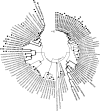Carbon and nitrogen metabolism in mycorrhizal networks and mycoheterotrophic plants of tropical forests: a stable isotope analysis
- PMID: 21527422
- PMCID: PMC3177289
- DOI: 10.1104/pp.111.177618
Carbon and nitrogen metabolism in mycorrhizal networks and mycoheterotrophic plants of tropical forests: a stable isotope analysis
Abstract
Most achlorophyllous mycoheterotrophic (MH) plants obtain carbon (C) from mycorrhizal networks and indirectly exploit nearby autotrophic plants. We compared overlooked tropical rainforest MH plants associating with arbuscular mycorrhizal fungi (AMF) to well-reported temperate MH plants associating with ectomycorrhizal basidiomycetes. We investigated (13)C and (15)N abundances of MH plants, green plants, and AMF spores in Caribbean rainforests. Whereas temperate MH plants and fungi have higher δ(13)C than canopy trees, these organisms displayed similar δ(13)C values in rainforests, suggesting differences in C exchanges. Although temperate green and MH plants differ in δ(15)N, they display similar (15)N abundances, and likely nitrogen (N) sources, in rainforests. Contrasting with the high N concentrations shared by temperate MH plants and their fungi, rainforest MH plants had lower N concentrations than AMF, suggesting differences in C/N of exchanged nutrients. We provide a framework for isotopic studies on AMF networks and suggest that MH plants in tropical and temperate regions evolved different physiologies to adapt in diverging environments.
Figures



References
-
- Abadie JC, Puttsepp U, Gebauer G, Faccio A, Bonfante P, Selosse MA. (2006) Cephalanthera longifolia (Neottieae, Orchidaceae) is mixotrophic: a comparative study between green and nonphotosynthetic individuals. Can J Bot 84: 1462–1477
-
- Alexander I, Selosse MA. (2009) Mycorrhizas in tropical forests: a neglected research imperative. New Phytol 182: 14–16 - PubMed
-
- Allen EB, Allen MF. (1990) The mediation of competition by mycorrhizae in successional and patchy environments. Grace JB, Tilman GD, , Perspectives on Plant Competition. Academic Press, New York, pp 367–389
-
- Bidartondo MI. (2005) The evolutionary ecology of myco-heterotrophy. New Phytol 167: 335–352 - PubMed
Publication types
MeSH terms
Substances
Associated data
- Actions
- Actions
- Actions
- Actions
- Actions
- Actions
- Actions
- Actions
- Actions
- Actions
- Actions
- Actions
- Actions
- Actions
- Actions
- Actions
- Actions
- Actions
- Actions
- Actions
- Actions
- Actions
- Actions
- Actions
- Actions
- Actions
- Actions
- Actions
- Actions
- Actions
- Actions
- Actions
- Actions
- Actions
- Actions
- Actions
- Actions
- Actions
- Actions
- Actions
- Actions
- Actions
- Actions
- Actions
- Actions
- Actions
- Actions
- Actions
- Actions
- Actions
- Actions
- Actions
LinkOut - more resources
Full Text Sources
Molecular Biology Databases

